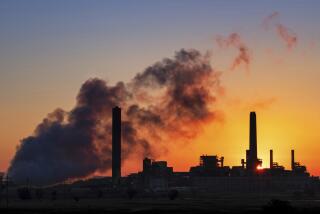The EPA’s long-overdue climate change ruling
The Environmental Protection Agency released a historic finding Monday that greenhouse gases are endangering public health and welfare. Rep. Darrell Issa (R-Vista), an outspoken critic of the theory of climate change and of congressional attempts to cut carbon, responded by issuing a statement headlined, “Why the Rush? What’s to Hide?”
We have a different question for the EPA: Why has it taken so long?
In 2007, the Supreme Court ruled that greenhouse gases were pollutants covered by the Clean Air Act, and it directed the EPA to determine whether they represented a health threat that would require federal regulation. Thus began more than a year and a half of foot-dragging by the Bush administration, which had reams of data pointing out the clear dangers of climate change but refused to take action. The EPA is hardly rushing to judgment by finally obeying the law and acknowledging the overwhelming worldwide consensus that carbon-fueled climate change threatens human health. Global warming is expected to cause deaths related to adverse temperatures, greater incidence of disease, worsened air quality, rising sea levels, more intense weather events and food and water shortages, among other things. These are not the conclusions of a handful of conspiracy-minded scientists at a British university, as climate skeptics would have people believe; the EPA’s finding was based primarily on the work of the U.S. Global Change Research Program, the Intergovernmental Panel on Climate Change and the National Research Council.
The finding by the EPA, which paves the way toward concrete regulatory limits on greenhouse gases, is the most significant action taken by the federal government to date to address the problem. That should make President Obama’s mission in Copenhagen next week a little bit easier. As global leaders convene to negotiate a worldwide climate treaty, all eyes are looking to the United States, the world’s second-biggest carbon emitter after China (and a far bigger polluter than China on a per capita basis). If the U.S. refuses to take strong steps, which it has done consistently until now, it’s unreasonable to ask or expect any other nation to do so.
Nonetheless, the EPA finding on its own isn’t enough to spur a breakthrough in Copenhagen. The agency has signaled that it plans to go after only the very largest polluters, at least initially. In March, it will issue guidelines on major sources such as oil refineries and coal-fired power plants; it is also expected to set rules on light-duty vehicles patterned on tailpipe emissions standards approved by California. That’s a nice start, but climate negotiators are looking for a strict commitment on economy-wide greenhouse gas emissions by 2020, something the EPA isn’t in a position to provide.
More important, the EPA action sends a strong message to the Senate, where progress on a crucial climate bill has stalled. The cap-and-trade system created by the bill is a market-based method for cutting carbon that would be less expensive to industry and consumers than the direct regulatory approach taken by the EPA. In other words: If you don’t like cap-and-trade, you’ll like the alternative less. That’s something even science-denying obstructionists ought to be able to understand.
More to Read
Get the L.A. Times Politics newsletter
Deeply reported insights into legislation, politics and policy from Sacramento, Washington and beyond. In your inbox three times per week.
You may occasionally receive promotional content from the Los Angeles Times.










